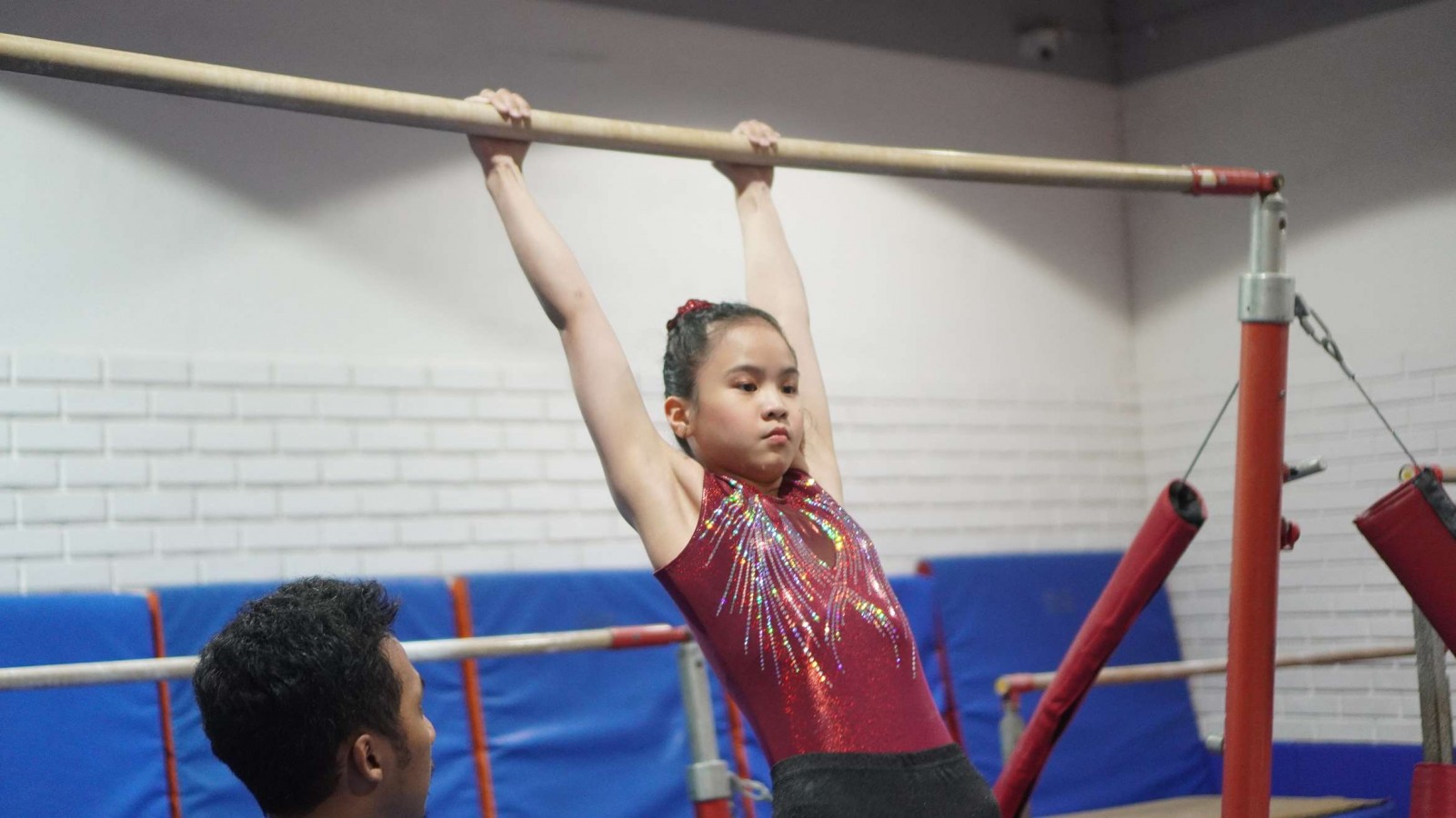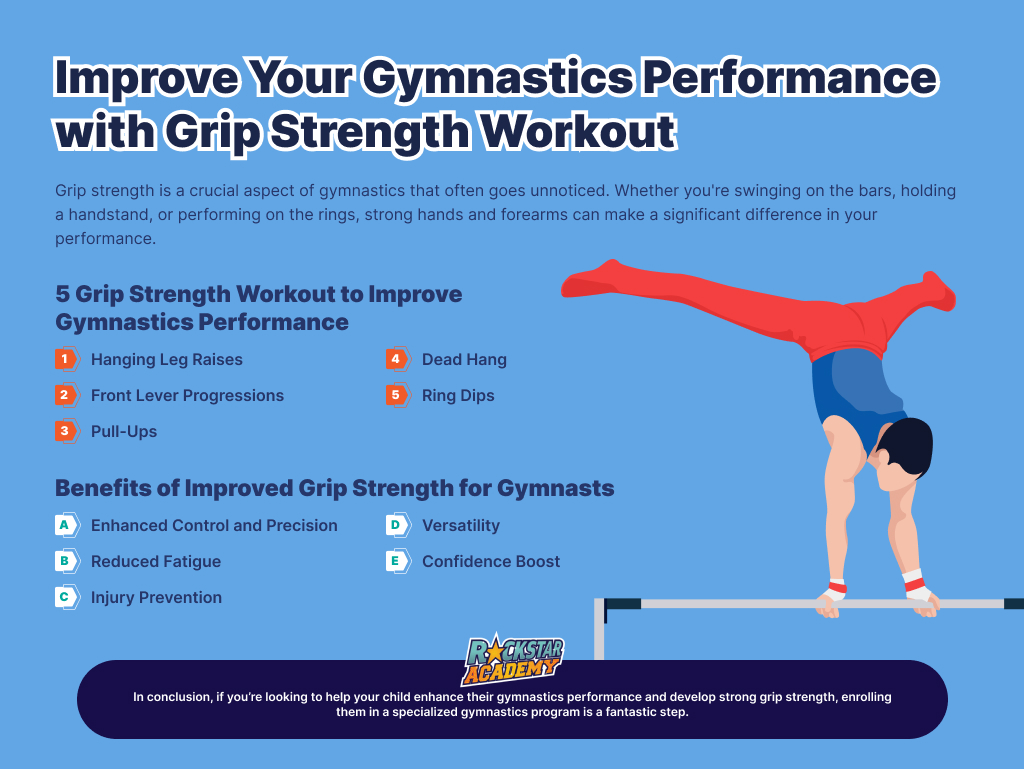Improve Your Gymnastics Performance with Grip Strength Workout

Grip strength is a crucial aspect of gymnastics that often goes unnoticed. Whether you're swinging on the bars, holding a handstand, or performing on the rings, strong hands and forearms can make a significant difference in your performance.
This article will guide you through how to improve your grip strength, explore various grip variations, and highlight the benefits of enhanced grip strength for gymnasts. Let's dive in!
5 Grip Strength Workout to Improve Gymnastics Performance
Improving grip strength is essential for gymnasts to enhance their performance, safety, and endurance. Here’s a detailed look at some effective grip strength workouts;
1. Hanging Leg Raises
Hanging leg raises are an essential exercise for gymnasts looking to boost arm strength and core stability.
While this exercise primarily focuses on the abdominal muscles, it also works the grip, shoulders, and forearms as the gymnast hangs from a bar. The controlled motion of lifting and lowering the legs requires significant upper body strength, which enhances overall body control.
As gymnasts progress, the strength developed from hanging leg raises improves their performance in movements that demand a strong and stable upper body.
Here’s How to Do It:
- Begin with your legs hanging straight down.
- Tighten your core and lift your legs upward, aiming to raise them as high as possible.
- Control the descent as you lower your legs back down.
- Avoid using momentum; concentrate on engaging your abdominal muscles.
2. Front Lever Progressions
Front lever progressions are essential for developing arm strength in gymnasts.
These exercises engage the arms, shoulders, and upper back while also challenging the core and overall body tension.
As gymnasts progress towards achieving a horizontal front lever position, they build significant strength in the biceps, forearms, and shoulders.
This series of exercises creates a solid foundation for controlling and manipulating the body in various planes, which is crucial for performing intricate and controlled gymnastics routines.
Here’s How to Do It:
- Start in a hanging position with palms facing forward.
- Tuck your knees towards your chest while pulling your shoulder blades down and back.
- Aim to reach a horizontal position with your body parallel to the ground.
- Keep tension in your core and engage your lats throughout the movement.
3. Pull-Ups
Pulling your body up to a parallel bar demands significant strength and a strong grip. After completing a set of pull-ups, you'll notice your forearms will be noticeably pumped.
Once you've mastered this bodyweight exercise, increase the difficulty and enhance grip strength by using fat grips or draping a couple of towels over the bar for an added challenge.
4. Dead Hang
Dead hangs are an excellent exercise for building grip strength. Simply hang from an overhead bar with your arms fully extended and your body in a hollow position. If you're new to this exercise, start by holding the bar for 20 to 30 seconds at a time. For more experienced individuals, increase the difficulty by adding weight.
5. Ring Dips
Ring dips are an outstanding arm exercise for gymnasts looking to build substantial arm strength. This movement primarily targets the triceps, shoulders, and chest, enhancing explosive pushing power.
The instability of the gymnastics rings requires greater muscle stabilization, improving overall upper body control.
Ring dips also engage the core, emphasizing the importance of a stable midsection in gymnastic movements.
As gymnasts become proficient in this exercise, they develop the strength needed for various dynamic maneuvers on the rings.
Here’s How to Do It:
- Grab the rings with a firm grip, palms facing inward.
- Jump or step into the rings, supporting your body weight on straight arms.
- Lower yourself by bending your elbows until your shoulders are below your elbows.
- Push back up to the starting position, fully extending your arms.
- Keep your body straight throughout the movement, engaging your core and chest.
Benefits of Improved Grip Strength for Gymnasts
Improving your grip strength can be a game-changer for gymnasts. Let's explore the various benefits here:
A. Enhanced Control and Precision
Think about how many times you need to hold onto something tightly in gymnastics – whether it's a bar, a ring, or even another part of your own body in different poses. Having a strong grip means you can control your movements better.
With better grip strength, you'll be able to execute moves more accurately. For example, when performing on the uneven bars, a firm grip allows you to swing and transition smoothly without slipping. This precision can make your routines look more polished and professional.
B. Reduced Fatigue
Gymnastics routines can be lengthy and demanding, requiring sustained effort from your muscles. If your grip tires quickly, it can affect your performance and make it harder to complete your routines.
Stronger hands and forearms can endure longer periods of activity. This means you can practice longer and perform more challenging routines without your grip giving out.
C. Injury Prevention
Safety is important in gymnastics. A weak grip can lead to slips and falls, which can result in injuries. Keeping a secure hold on apparatuses is essential to avoid accidents.
With a stronger grip, you're less likely to slip off the bars or rings. This reduces the risk of falls and the injuries that can come with them.
D. Versatility
Gymnasts often need to switch between different skills and apparatuses quickly. Each apparatus requires a different type of grip and control. Being versatile with your grip strength can make these transitions smoother.
Improved grip strength makes it easier to adapt to various apparatuses like rings, bars, and beams. For example, the grip needed for swinging on the high bar is different from what’s needed on the parallel bars. With strong, adaptable grips, you can transition between these seamlessly, making your overall performance more fluid and versatile.
E. Confidence Boost
Confidence plays a huge role in gymnastics. When you trust your body’s capabilities, you can perform with more assurance and less hesitation.
Knowing that you have a strong and reliable grip can boost your confidence. You’ll feel more secure attempting new and challenging moves because you know your hands can handle it. This increased confidence can lead to more daring performances and quicker progression in your skills.
Have You Tried These Grip Strength Workouts?
In conclusion, if you’re looking to help your child enhance their gymnastics performance and develop strong grip strength, enrolling them in a specialized gymnastics program is a fantastic step.
Rockstar Academy, the leading Sports & Performing Arts Academy, offers exceptional gymnastics programs designed to improve skills, including grip strength.
Their comprehensive curriculum includes Gymnastics Testing, which supports students in advancing to higher levels and preparing for national and international competitions.
Additionally, the Gymnastics Elite Championships foster high achievement standards, discipline, good sportsmanship, and effective handling of both wins and losses. To give your child a head start, Rockstar Academy even offers a free trial class.
Don’t miss out on this opportunity, go contact Rockstar Academy today to learn more and get started on your child's gymnastics journey!

FAQ
How often should I do grip strength exercises?
Aim to include grip strength exercises 2-3 times per week in your training routine. Consistency is key, but be sure to allow your muscles to recover between sessions.
Can children do grip strength exercises?
Yes, children can perform age-appropriate grip strength exercises, such as squeezing stress balls or using light resistance bands. Always ensure exercises are supervised and suitable for their age and development level.
How long does it take to see improvements in grip strength?
With consistent training, you can start noticing improvements in grip strength within a few weeks. However, significant changes typically occur over several months of regular exercise.
Can grip strength training improve my overall gymnastics performance?
Absolutely! Improved grip strength enhances your control, precision, and endurance, contributing to better performance across various gymnastics disciplines.



